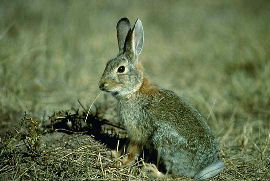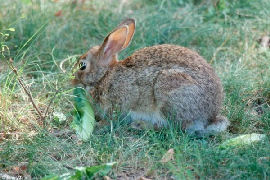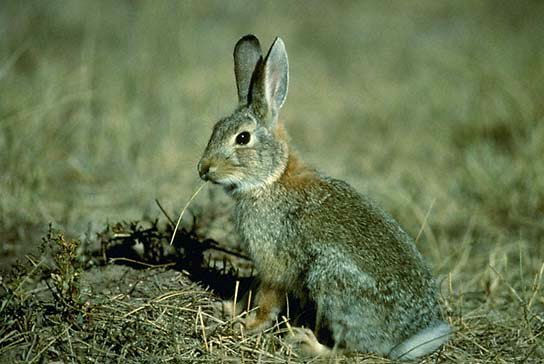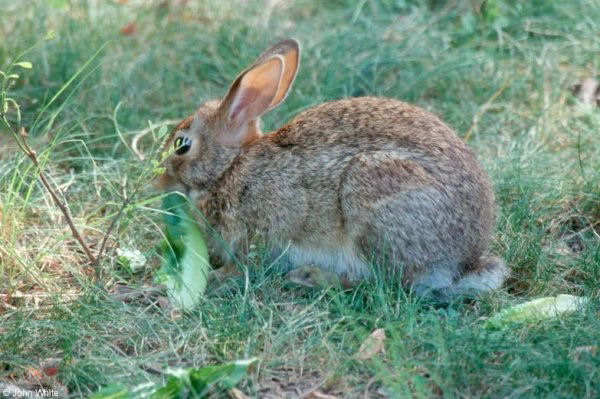Rabbits and Hares
Description
The familiar cottontail of eastern U.S. Grayish brown above, grizzled with black; forehead often has white spot. Distinct rust-colored nape. Tail cottony white below. Feet whitish above. Long ears. L 14 3/4–18 1/4" (375–463 mm); T 1 1/2–2 1/2" (39–65 mm); HF 3 3/8"–4 1/8" (87–104 mm); E 1 7/8–2 5/8" (49–68 mm); Wt 2–4 lb (900–1,800 g).
Similar Species
New England Cottontail usually lacks rust-colored nape and has black patch between ears. Desert Cottontail is usually smaller, with slightly longer ears. Marsh and Swamp rabbits have rust-colored feet. Snowshoe Hare is usually larger and uniform dark brown in summer.
Habitat
Brushy areas, old fields, woods, and cultivated areas; especially around thickets and brush piles.
Range
Eastern U.S. except for New England; west through North Dakota, Kansas, Texas; also in n New Mexico and Arizona.
Discussion
The most common rabbit in much of the U.S., the Eastern Cottontail is primarily nocturnal, but is abroad near dawn and dusk and often on dark days. On midwinter nights, groups of cottontails have been seen frolicking on crusted snow. Cottontails usually hop, but they can leap 10 to 15 feet (3–4.5 m); sometimes they stand on their hindfeet to view their surroundings. When pursued, they usually circle their territory and often jump sideways to break their scent trail. They dislike getting wet but will swim if pressed. In winter, where brush is strong enough to hold a covering blanket of snow, they may make a network of runways beneath it. In cold weather, they often take shelter in Woodchuck burrows. This species feeds on many different plants, mainly herbaceous varieties in summer and woody varieties in winter. As is the case with many lagomorphs, in addition to producing typical fecal pellets, the Eastern Cottontail will feed rapidly, then retreat to the safety of a brush pile or other shelter and defecate soft green pellets, to be eaten at leisure. During the breeding season, males fight one another and perform dance-like courtship displays before the territorial females. These displays involve face-offs and much jumping, including females jumping over males. Individuals often jump straight up into the air, and pairs or small groups often engage in active chases. The young are born in a nest lined with plant material and fur from the mother’s breast. The nest cavity, in a hollow in the ground, is about 7 inches (180 mm) deep and 5 inches (125 mm) wide. The top of the nest is capped over with vegetation; nests in lawns are often exposed when lawn mowers take the tops off. The young are nursed at dawn and dusk. Within hours after giving birth the female mates again. If no young were lost, a single pair, together with their offspring, could produce 350,000 rabbits in five years. However, this rabbit’s death rate vies with its birth rate; few individuals live longer than one year.




